Has Water Damaged your Engineered Wood Floors? Not sure how to Dry out water-soaked Engineered Flooring or how to repair it?
In this guide you will learn:
- What Happens when Engineered Wood Floorings Get wet & If they can be repaired,
- How to Remove Water & Moisture from your Engineered wood floors,
- How to Repair or Replace them,
- What to do if there is water UNDER your Engineered wood flooring.
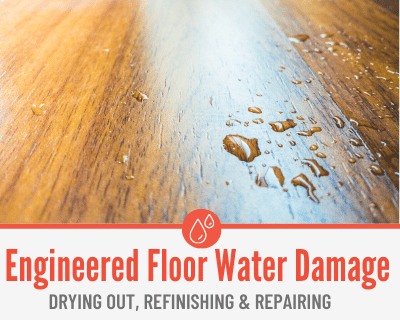
Engineered hardwood flooring offers the elegance of solid hardwood, but at a reduced cost and with a somewhat easier installation.
When engineered wood floors get wet, however, it can be problematic, and you’ll want to act quickly.
In this guide, we’ll answer some common questions about Engineered Hardwood Floors that have been exposed to water either from a leak or flood and what can be done to save them.
Is Engineered wood Flooring Waterproof?
Engineered wood flooring certainly isn’t waterproof. While some variations of engineered flooring are designed to handle greater humidity throughout the year, engineered flooring is still made of wood after all, and wood absorbs moisture.
New variations of engineered hardwood are made with a vinyl core and a wooden layer on top, known as engineered vinyl plank or “EVP.” EVP is a relatively new type of flooring, and boasts itself as being waterproof, but the top layer is still made of wood, not to mention it hasn’t been around as long so the effects of water damage on it aren’t as well documented.
Other, cheaper variations of engineered wooden flooring are made with layers of MDF underneath, which has a tendency to swell and cause a whole slew of other problems when it gets wet.
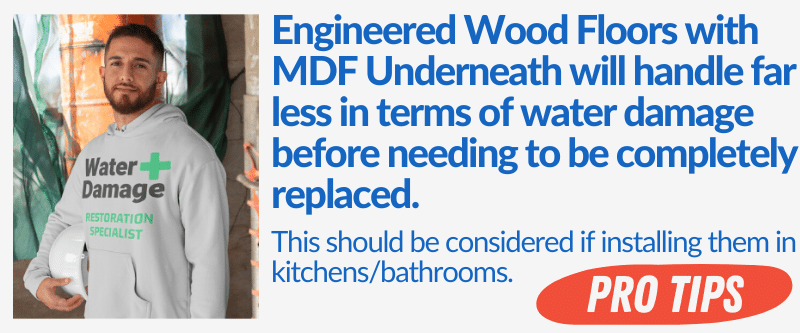
What Happens when Engineered Wood Floors Get Wet?
Over time, if left exposed to water or moisture, a number of serious issues can arise, including:
Buckling/Warping
This occurs when the soft plywood core is allowed to absorb too much moisture. When the planks of engineered wood flooring finally dry out, they will twist and begin to distort, causing the edges to rise up and resulting in uneven flooring that can become hazardous.
Once buckling or warping occurs, it can be difficult to fix with engineered hardwood given the nature of their composition, but there are methods
Cracked finish
In some cases, the top layer of hardwood can begin to split apart, causing large cracks in the hardwood layer itself. Anyone who has had the misfortune of sliding across a hardwood floor and getting a nasty splinter can tell you just how much of an issue this can be.
Cracks can generally be fixed if the floors are given time to dry out completely, but you’ll want to ensure the integrity of the flooring first before deciding whether to repair or replace it.
Delamination
Delamination is when the top flooring layer or your engineered wood flooring separates from the core underneath it.
It can occur if water is able to get between the top layer and the core of the engineered wood flooring, eroding away or damaging the adhesive that holds them together.
Once this happens, the flooring will more than likely need replaced.
Discoloration
In other instances, the water may leave visible stains or spots in the hardwood layer, otherwise known as discoloration. These will be easily noticed as mottled areas that can be lighter or darker than the natural color of the wood.
While unsightly, it doesn’t necessarily denote that the integrity of the engineered wood flooring has been compromised, although it will be riskier trying to repair it on engineered flooring than it would on standard solid hardwood.
Bubbling
Similar to delamination, bubbling is when sections of the top layer of hardwood begin to separate from the core underneath, though in the case of bubbling they will begin to rise up, causing uneven flooring.
If bubbling is occurring on your water-damaged engineered wood flooring, it means water has gotten between the top layer and the core of your flooring, and there isn’t much hope for repair.
Mold growth
Possibly the most dangerous on the list, mold growth can occur when moisture is left to sit in your engineered wood flooring for too long, creating a damp environment for mold and mildew to thrive.
Denoted by speckled spots in a variety of colors or a fuzzy grown that starts to appear on the floor or in the cracks between planks, mold growth poses a serious health hazard and should be dealt with immediately.
Water Damaged Engineered Wood Floors?
Call 844-488-0570 for a Risk Free estimate from a Licensed Water Damage Restoration Specialist in your area.
We Can Help Dry out & Repair your Engineered Floors.
Will Water Ruin Engineered Hardwood Flooring Every Time?
While water won’t necessarily ruin your engineered hardwood flooring every time, most engineered flooring has a softwood core that is not water resistant, and when it absorbs enough water it will start to expand, causing issues like cupping or buckling.
Once this happens, repairing water-affected engineered floors can be difficult, because the thin layer of hardwood on top isn’t as resistant to sanding as solid hardwood.
Each instance should be taken on a case-by-case basis.
If your water damage is a result of major flooding, replacing your flooring is highly recommended as they’ll have absorbed a substantial amount of water and pose a serious risk of mold growth.
If the damage appears merely cosmetic, as in the case of discoloration, you can attempt to repair the damage yourself. Exercise caution at all times, and if you ever feel as though you’re doing more damage than repairs, stop and contact a professional.
Can Engineered Wood Flooring Water Damage Be Repaired?
Yes, water damage on Engineered Flooring can be repaired, although as previously stated you’ll need to be much more careful than you would with solid hardwood.
Whereas cupping or buckling can be sanded down with solid hardwood, engineered hardwood’s top layer is only so thick, usually between 0.1-0.3 of an inch.
That doesn’t leave much room for error, not to mention repeat sanding.
If your engineered flooring is made with MDF instead of soft plywood or vinyl core, there’s a much greater chance you’ll need to have it replaced, but if you’re confident in your ability and the integrity of the flooring, we’ll go over how to tackle repairing your engineered floors.
Repairing Engineered Wood Floor Water Damage
How to know when to fix or replace
First and foremost, any time you feel as though a repair is beyond your capabilities, or are unsure if it is safe to repair your flooring, don’t hesitate to contact a professional for help.
If done incorrectly, repairs can wind up costing you more than if you had gotten help to begin with, not to mention could pose a danger to you and anyone else living in the house.
That being said, when deciding whether to replace or repair your engineered flooring on your own, there are several factors involved.
This includes:
- The extent of the damage
- How long was the material in contact with water
- The cost of materials and tools be in repairing versus replacing
- Whether or not the subflooring sustained any damage
If your flooring has sustained more serious damage, such as delamination or bubbling, it might be wiser to at least replace those planks than to try and repair them.
Especially in the case of MDF or soft plywood, simply nailing it back down isn’t a viable solution, as the wood underneath will shift and reposition as its moisture levels fluctuate.
This will loosen the nail over time, which can fall out or leave the top layer loose, both of which can be hazardous especially if there are little ones in the home.
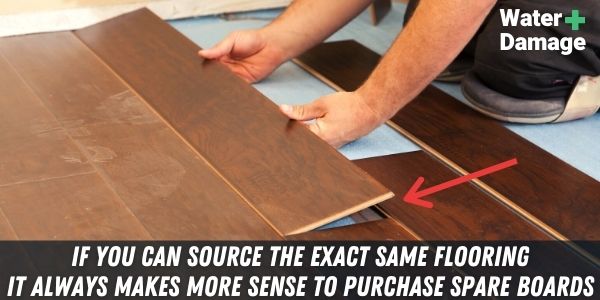
How to remove water and moisture
For a more comprehensive guide to removing water and moisture from your Engineered flooring see this guide: How to Dry out Hardwood Floors
As far as a basic run down, though, here’s what you need to know:
- Get as much water up off the floor as you can
- Clean the floors with a cleaning solution, specifically one for engineered hardwood in this instance, and follow the directions on it
- Use fans and dehumidifiers to dry out the wood, and leave them running on the highest setting
- Be patient, as the process could take days, weeks, or even months depending on how much water was absorbed and environmental factors
- Check the floor with a moisture meter to ensure it is completely dried before attempting any repairs
Refinishing Water Damaged Engineered Flooring & Removing Stains
In certain situations, you may find it necessary to refinish your engineered flooring.
Things like discoloration and the like can cause mismatched finishing, so you’ll want to take a few precautions when attempting to restore the look of your engineered hardwood.
Only sand engineered floors that have a thick enough veneer
Most engineered floors have a top layer that is only a few millimeters thick, so you’ll want to do some research and find out the specifications of your type of flooring.
If sanded too far down or too many times, you can wind up sanding through the veneer, at which point that plank is ruined and will need to be replaced.
Make sure you match the stain color correctly
When sanding down and refinishing any type of wood, it’s important you match the color of the other sections. If you’re able, take a sample of the flooring in when you’re purchasing materials, and if you find you’re having trouble matching colors don’t hesitate to ask for help.
Using the wrong stain color can leave large patches that stand out on the floor, which is what you’re trying to avoid in the first place.
Depending on the type of hardwood used for the veneer, you’ll want to consider your application method. The safest bet is an old cloth, or a foam brush. Rub or brush the stain against the direction of the grain, as it will help fill in the pores of the wood better.
Keep in mind, the longer you leave the stain on, the more it will absorb and the darker the color will become, so make sure you’re staying consistent as you go.
One last thing to remember is this process only provides color, not protection. Staining the flooring will restore the appearance, but you’ll need to apply a clear finish when you’re done to protect not only the wood but the stain itself.
If your veneer isn’t thick enough to be sanded, glazing is another option
Glazing is a method of changing your floors coloring without having to sand it down.
If the veneer on your engineered flooring is thinner than others, has already been sanded once or twice, or if you’re concerned for any reason about sanding it down, you can apply a glaze.
One thing to keep in mind with glazing, however, is that they do wear off and chip away as time goes on, so the results aren’t going to be as permanent as if you hand sanded and refinished.
Make sure the floor is wiped clean before applying a glaze, and select a color that will work well with the pre-existing wood and its finish.
The color of the glaze you apply is going to mix with whatever color stain your flooring currently has, so you’ll want to ensure they compliment each other or you’ll just end up wasting money and making more work for yourself.
A layer of clear coat finish once the glaze has been applied can help it last longer, just make sure it’s had a chance to completely dry before doing so.
Repairing Engineered Wood Floors can be Quite a Hassle!
Call 844-488-0570 for a Risk Free estimate from a Licensed Water Damaged Floor Restoration Specialist in your area.
We Can Help Dry out & Repair your Engineered Wood Flooring!
Replacing Water Damaged Engineered Hardwood Floors
If worse should come to worse, replacing planks of your water-damaged engineered wood flooring might be your best bet.
Be that the case, there’s a few things you’ll need, and you’ll want to gather them all beforehand.
- A prybar
- A hammer with cat’s paw
- New floor planks that match your current flooring
- Trim nails
- Nailset
- Eye protection, such as work glasses or goggles
Whereas solid hardwood floors are typically nailed or glued into place, engineered hardwood are often what is referred to as “floating floors.”
This means they’re merely sitting on the subflooring, held down by the trim, so it’s easier to replace a plank or two in the middle than it would be with solid hardwood.
You’ll start by removing the floor trim with your prybar and hammer. Be careful when doing so, because you don’t want to break the wood.
Tap out nails with your hammer from your engineered wood flooring boards, and set the trim aside. Be sure to wear eye protection while removing the trim.
Next, you’ll start at the wall closest to the boards you’re replacing, and separate the boards by pushing them towards the small gap next to the wall. Remove them as you’re able, sliding them over towards the gap which should now be increasing in size, and setting aside any that are undamaged to use again later.
Be sure to keep track of the order they were in, so you can lay them back the way they were before.
Once you reach the water damaged boards, remove them and set them off to the side, away from the others.
Since you won’t be reusing them, you don’t want them to get mixed in with the good ones.
From there, it should be a simple matter of laying the new boards down and snapping them into place with the others.
After that, you can continue laying the previously removed undamaged boards that you had set aside earlier. Slide them in along the gap, and snap them into place as you did before.
Continue to do this until you reach the wall again, and are able to snap the final plank back into position.
From there, it should be a simple matter of reinstalling the trim. Utilizing the hammer, nails, and nailset, use new nails but try to stay in the same nail holes from before. If you still have nails sticking through your trim pieces, now would be the time to remove them all.
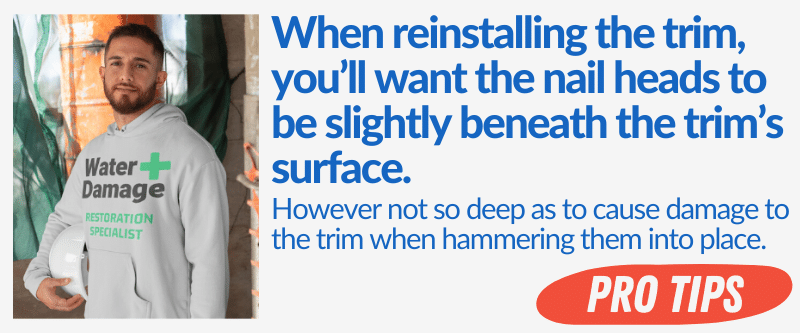
Water Under Engineered Wood Floor
There are two main issues with getting water underneath your engineered wood flooring. First and foremost, it can damage the soft plywood or MDF core, causing all of the problems mentioned above.
Secondly, and this is just as important, it can cause all kinds of damage to your subflooring, which could eventually leak through to the ceiling below if there is a room beneath it.
If you get water beneath your engineered wood flooring, you’ll want to act quickly to dry it out.
Utilizing the outlined methods above involving fans and a dehumidifier, if there is a great deal of water between the flooring and subfloor you should consider removing a few planks to allow air to circulate underneath the flooring, or at the very least removing a few planks and spreading the ones that remain out so it can dry out more quickly.
Time is of the essence when it comes to getting your Engineered Wood floors dried out.
How to Protect Engineered Wood Floors from Water Damage
While there’s no 100% guaranteed method of protecting your engineered floors from water damage, there are ways to help make it more resistant and to mitigate any damage that may occur.
The best method is outright prevention; having your plumbing checked regularly, monitoring for any sources of water that may be splashing or leaking onto it, and staying vigilant.
Vinyl core engineered flooring is made to be more water resistant by design, and while there isn’t as much documentation as to the effects water can have on it, vinyl is a non-porous material and will not absorb moisture like soft plywood and MDF.
All that being said, there are waterproofing treatments you can apply.
Just be certain that whatever you’re using isn’t going to damage your floors, and follow the instructions carefully when applying.
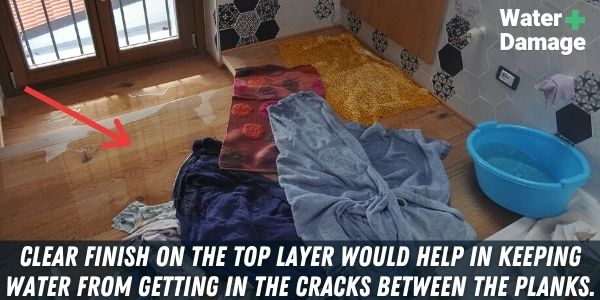
When to Call a Professional?
Any time your home has been subjected to flood damage, it is highly recommended you call a professional.
They have specialized training and tools to help them assess the extent of the water damage to your engineered floors, and ensure greater hazards like mold growth or serious damage to your subflooring aren’t present.
That being said, if at any point you feel uncomfortable making a repair, or if the extent of the damage seems beyond your abilities, don’t hesitate to get a hold of someone.
Online resources can be great at helping you along your way, but if you’re on the fence about calling in a professional, chances are that means it’s time.
Act sooner rather than later, and you’ll maximize your chances of saving your engineered flooring rather than having to replace it entirely.
We have Water Damage Restoration Technicians that can help Restore your Engineered Wood Flooring
For Disasters of all Sizes, available in 95% of the USA.
